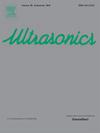基于啁啾编码激励的增强横波弹性成像方法。
IF 3.8
2区 物理与天体物理
Q1 ACOUSTICS
引用次数: 0
摘要
剪切波弹性成像(SWE)是一种检测组织在声辐射力(ARF)作用下产生的剪切波,并通过分析剪切波的传播速度来表征软组织力学特性的成像技术。ARF通过超声波的非线性传播引起能量密度的变化,从而驱动组织产生剪切波。然而,ARF产生的剪切波振幅较弱,且剪切波在体内被强烈衰减。此外,剪切波在深部通常被噪声淹没,这给剪切波的检测和低信噪比带来了挑战。本文研究了在基于arf的横波弹性学中应用啁啾编码信号进行横波激励(Chirp- swe)的可行性。利用推力波形的啁啾编码激励来增强ARF的作用,从而有效地激励剪切波。用常规正弦长脉冲(SWE)和巴克编码信号(Barker-SWE)进行了对比实验。理论和仿真结果分析表明,与传统SWE和Barker-SWE相比,Chirp-SWE能提高约10%的激发能。弹性模体实验结果表明,Chirp-SWE获得的平均轴向粒子速度峰值高出约30%-50%,有利于形成更稳定的剪切波。此外,它在弹性测量中表现出更高的信噪比。体外肝脏实验进一步验证了在组织中实施Chirp-SWE的可行性。结果证明了推波啁啾编码激励在改善横波弹性成像结果方面的可行性和优越性。预计这将提高软组织弹性成像的准确性和鲁棒性。本文章由计算机程序翻译,如有差异,请以英文原文为准。
A method of enhanced shear wave elastography based on Chirp coded excitation
Shear Wave Elastography (SWE) is an imaging technique that detects shear waves generated by tissue excited by Acoustic Radiation Force (ARF), and characterizes the mechanical properties of soft tissue by analyzing the propagation velocity of shear wave. ARF induces a change in energy density through the nonlinear propagation of ultrasound waves, which drives the tissue to generate shear waves. However, the amplitude of shear waves generated by ARF is weak, and the shear waves are strongly attenuated in vivo. Furthermore, the shear waves are usually drowned out by noise at deep locations, which presents a challenge in the detection of shear waves and low signal-to-noise ratios. In this paper, we investigate the feasibility of applying the Chirp coded signal for shear wave excitation (Chirp-SWE) in ARF-based shear wave elastography. The use of Chirp coded excitation of push waveforms was employed to enhance the action of ARF, thereby effectively exciting shear waves. Comparative experiments were carried out with conventional sine long pulses (SWE) and the Barker coded signal (Barker-SWE). The analysis of theoretical and simulation results revealed that Chirp-SWE could increase the excitation energy by approximately 10% compared to conventional SWE and Barker-SWE. The results of the elastic phantom experiments demonstrated that the average peak axial particle velocity obtained by Chirp-SWE was approximately 30%–50% higher, which facilitated the formation of a more stable shear wave. Additionally, it exhibited a higher signal-to-noise ratio during elasticity measurements. The in vitro liver experiments further validated the feasibility of implementing Chirp-SWE in tissues. The results demonstrated the feasibility and advantages of Chirp coded excitation of push waveforms in improving shear wave elastography results. It is expected that this will enhance the accuracy and robustness of soft tissue elastography.
求助全文
通过发布文献求助,成功后即可免费获取论文全文。
去求助
来源期刊

Ultrasonics
医学-核医学
CiteScore
7.60
自引率
19.00%
发文量
186
审稿时长
3.9 months
期刊介绍:
Ultrasonics is the only internationally established journal which covers the entire field of ultrasound research and technology and all its many applications. Ultrasonics contains a variety of sections to keep readers fully informed and up-to-date on the whole spectrum of research and development throughout the world. Ultrasonics publishes papers of exceptional quality and of relevance to both academia and industry. Manuscripts in which ultrasonics is a central issue and not simply an incidental tool or minor issue, are welcomed.
As well as top quality original research papers and review articles by world renowned experts, Ultrasonics also regularly features short communications, a calendar of forthcoming events and special issues dedicated to topical subjects.
 求助内容:
求助内容: 应助结果提醒方式:
应助结果提醒方式:


